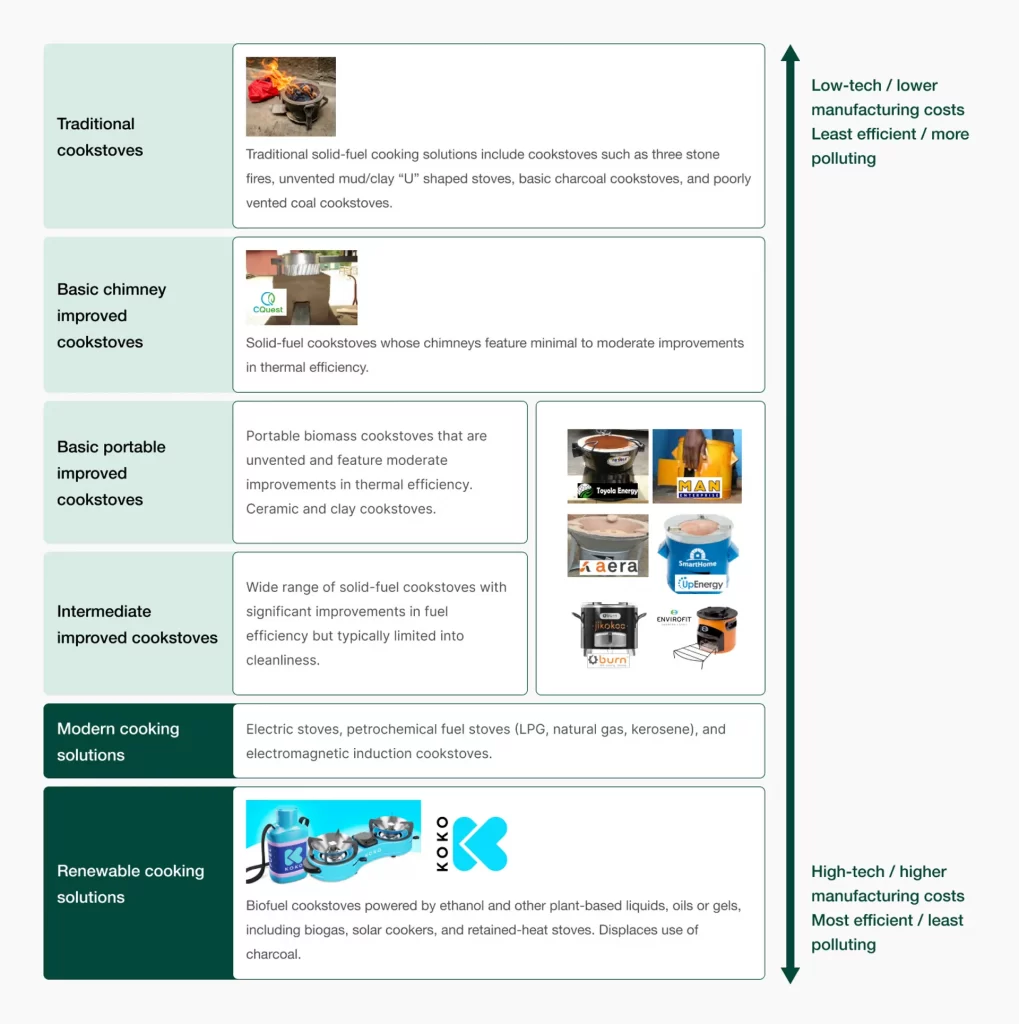Introduction
Cookstove credits are a form of carbon credit specifically designed to support the distribution and use of clean and efficient cookstoves in developing regions. These credits are generated through projects that replace traditional, inefficient, and polluting cooking methods (like open fires or basic stoves using solid fuels) with cleaner technologies. This article explores the different types of cookstoves, explains how cookstove credits are generated, and discusses their benefits and the controversies they face.
Types of Cookstoves
Traditional Cookstoves
In many parts of the world, traditional cookstoves and open fires are the primary means of cooking and heating. These methods rely on burning biomass such as wood, charcoal, and animal dung. The combustion process is often inefficient and produces large amounts of smoke and soot, contributing to indoor and outdoor air pollution. The health implications are severe, with millions suffering from respiratory diseases linked to the inhalation of toxic fumes.
Improved Cookstoves
Improved cookstoves are designed to be more efficient and less polluting than traditional biomass stoves. They usually incorporate features to enhance combustion efficiency, reduce the amount of fuel needed, and decrease smoke emissions. Common characteristics include:
- Better combustion chambers that ensure more complete burning of fuel.
- Insulation to keep heat concentrated where it’s needed.
- Chimneys or ventilation systems to direct harmful smoke away from users.
These stoves can use the same traditional fuels (like wood or charcoal) but do so more efficiently and cleanly, making them a practical and affordable option in many settings.

Biogas Cookstoves
Biogas cookstoves run on biogas, which is produced from organic waste through a process called anaerobic digestion. The key components of a biogas system include a digester (where the breakdown of organic material occurs) and a storage area for the resulting biogas. Benefits include:
- Use of renewable resources like animal dung, kitchen waste, or agricultural residues.
- Very low emissions, as biogas burns cleanly, producing only carbon dioxide and water vapor.
- Additional benefits like the production of slurry from the digester, which can be used as a high-quality fertilizer.
- Biogas systems are particularly well-suited to rural areas where there is ample organic waste material and space to install a digester.

Solar Cookstoves
Solar cookstoves use the sun’s energy to heat food, requiring no fuel and producing no emissions. They come in various designs, including:
- Parabolic solar cookers which use curved reflective surfaces to concentrate sunlight onto a pot or pan.
- Box cookers which capture and retain heat in an insulated box with a transparent lid.
- Panel cookers which combine elements of both box and parabolic designs.
Solar cookstoves are sustainable and cost-effective over time but are limited by weather conditions and daylight availability.

Bioethanol Cookstoves
These stoves use ethanol derived from biomass (such as sugarcane, corn, or cellulose) as their fuel source. Ethanol is a clean-burning liquid fuel, and stoves designed to use it are typically:
- Highly efficient with good control over flame intensity.
- Clean-burning, producing minimal smoke and harmful emissions.
- Suitable for urban areas where transporting and storing solid fuels might be problematic.
Bioethanol is a renewable fuel, but its production and availability can be influenced by local agricultural practices and policies.

Cookstove Credit Generation Process
The generation of cookstove credits is a meticulous process that involves several key stages. These credits play a crucial role in offsetting carbon emissions by promoting the adoption of energy-efficient cookstoves.
Project Identification and Development: The first step in generating cookstove credits involves identifying a suitable location and community where traditional cooking methods are prevalent and pose significant health and environmental issues. Stakeholders, including NGOs, local governments, and community organizations, collaborate to develop a project plan. This plan includes selecting an appropriate cookstove technology that matches the local cooking habits, fuel availability, and cultural preferences.
Baseline Assessment: A baseline study is conducted to assess the current cooking methods and the associated emissions. This involves quantifying the amount of biomass (like wood or charcoal) used, as well as the emissions of carbon dioxide, methane, and other pollutants produced by traditional stoves. The baseline data are crucial as they provide a reference against which the emission reductions from the new cookstoves can be measured.
Implementation: With a plan in place, the project moves to the implementation phase, which includes procuring and distributing the improved cookstoves. Training sessions are often held to educate the local community on how to effectively use and maintain the stoves. The implementation phase may also involve setting up local production or assembly facilities for the stoves to promote economic development and ensure supply chain sustainability.
Monitoring and Verification: After the cookstoves are distributed, ongoing monitoring is essential to ensure that they are used properly and continue to function effectively. This monitoring involves regular visits to households, surveys, and gathering data on fuel usage and stove conditions. Independent third-party verifiers are typically involved in this stage to assess the project’s impact on emissions reduction. They collect and verify data to ensure compliance with international standards and methodologies.
Calculation of Emission Reductions: Using the data collected during monitoring, the project calculates the reduction in emissions achieved by comparing current emissions from the new stoves to the baseline emissions. This calculation considers factors like the decrease in biomass used and the improved efficiency of the new stoves. The verified emission reductions are then translated into cookstove credits, where one credit usually represents one metric ton of CO2 equivalent reduced.
Certification and Issuance of Credits: Once the emission reductions are verified, they are certified by a recognized standard, such as the Verified Carbon Standard (VCS) or the Gold Standard. These standards ensure that the credits are credible and meet specific environmental and social criteria. After certification, the credits are issued and can be sold on carbon markets to buyers looking to offset their emissions.
Sale and Revenue Flow: The final step involves selling the certified cookstove credits on the voluntary carbon market. Revenue generated from the sale of credits is often reinvested into the project to cover operational costs, expand the distribution of cookstoves, or fund other community development initiatives. This revenue is also used to ensure the project’s sustainability and scalability.

Benefits of Cookstove Projects
Cookstove projects offer a range of benefits that extend far beyond the reduction of carbon emissions, touching on environmental, health, and socioeconomic aspects of the communities they serve. These benefits are critical not only in fighting climate change but also in improving the quality of life for individuals in developing regions.
Environmental Benefits
- Reduced Deforestation: Traditional cooking methods often require large amounts of wood, leading to deforestation and degradation of habitats. By using less wood or switching to alternative fuels, improved cookstoves help preserve forests and biodiversity.
- Lower Emissions: Efficient cookstoves emit fewer pollutants, including carbon monoxide, particulates, and other harmful chemicals, contributing to cleaner air and a healthier environment. This reduction is crucial in the fight against climate change as it decreases the amount of greenhouse gases released into the atmosphere.
Health Benefits
- Improved Indoor Air Quality: One of the most significant benefits of clean cookstoves is the substantial reduction in indoor air pollution. Traditional stoves produce high levels of smoke and soot, which are major contributors to respiratory illnesses, cardiovascular diseases, and other health issues. Efficient cookstoves reduce exposure to these harmful pollutants, thereby lowering the incidence of disease.
- Reduced Risk of Burns and Injuries: Improved stoves are often safer to use. They are typically more stable and enclosed, reducing the risk of accidental burns. This safety feature is especially important in households with small children.
Socioeconomic Benefits
- Time and Cost Efficiency: Efficient cookstoves use less fuel, reducing the time and money that families spend on gathering or purchasing wood or other fuels. This saved time can be redirected towards income-generating activities, education, or community involvement.
- Economic Opportunities: Cookstove projects often involve local communities in the assembly, distribution, and maintenance of stoves, creating jobs and supporting local economies. Additionally, the production of biomass fuels like biogas or bioethanol can provide further economic opportunities in rural areas.
- Gender Empowerment: Since cooking and fuel gathering are tasks often assigned to women and girls in many cultures, the reduced need for fuel and improved efficiency of cookstoves can have a liberating effect on women. This change allows women more time to engage in other activities, including education and entrepreneurship, thus promoting gender equality.
- Cultural Acceptance and Community Engagement: Projects that are sensitive to local cooking habits and cultural preferences tend to see higher acceptance and continued use of improved cookstoves. Engagement with the community during the planning and implementation phases increases the likelihood of a project’s success and sustainability.
Educational and Awareness Benefits
- Increased Awareness of Environmental Issues: Cookstove projects often include educational components about the benefits of reducing deforestation and the importance of sustainable energy use, which can lead to broader environmental awareness and actions beyond just the use of an improved cookstove.
- Training and Capacity Building: Many projects also provide training for local people not only in how to use and maintain the new stoves but also in basic repair and troubleshooting, which builds local capacity and resilience.
Global Impact: Contribution to Global Sustainability Goals: By addressing issues such as clean energy, health, economic growth, and climate action, cookstove projects contribute directly to the achievement of multiple United Nations Sustainable Development Goals (SDGs).

Controversies and Challenges Surrounding Cookstove Projects
While cookstove projects have gained popularity as a sustainable intervention for reducing emissions and improving public health in developing countries, they also face various controversies and challenges. These issues often stem from the complexities of project implementation, cultural fit, and the actual efficacy of the interventions. Here’s a closer look at some of these controversies and challenges:
Effectiveness of Cookstoves: One of the primary controversies involves the actual effectiveness of improved cookstoves in consistently delivering the promised reductions in fuel use and emissions. Studies have shown that the performance of cookstoves can vary dramatically depending on factors like design, user handling, and maintenance. Some cookstoves may not perform in real-world settings as well as they do in controlled testing environments, leading to smaller reductions in emissions and less significant health improvements than anticipated.
For example, cookstove projects in India have been scrutinized for overestimating climate benefits, as highlighted in a detailed analysis by Climate Home News. Many projects, predominantly in rural areas, distributed “improved” cookstoves intended to reduce firewood use and emissions. However, the actual impact and effectiveness of these stoves have been questioned due to issues like rapid deterioration and inadequate maintenance, leading to continued use of traditional cooking methods. This controversy emphasizes problems with verification processes and inflated emission reduction claims in the carbon credit market. Additionally, the methodology used for calculating emissions reductions is criticized for allowing exaggerated claims that do not align with actual benefits. This situation underscores the need for stricter monitoring and genuine impact assessments in carbon offsetting initiatives.
Sustainability and Adoption Rates: Ensuring sustained use of improved cookstoves presents a significant challenge. In some instances, households revert to using traditional stoves alongside or instead of the new technology, often due to issues with the new stoves that were not anticipated during the project planning phase, such as longer cooking times or difficulty in repairing them. Cultural preferences and cooking practices can also affect adoption rates, as some communities may resist changing their traditional cooking methods.
Measurement and Verification of Emission Reductions: Accurately measuring and verifying the reductions in greenhouse gas emissions is complex and fraught with potential for error. The variability in how stoves are used—such as the type and moisture content of the biomass fuel—can affect emission levels. Moreover, verifying these reductions requires robust monitoring and data collection, which can be challenging in remote or less accessible regions.
Carbon Market Fluctuations: The financial model of many cookstove projects is based on the generation and sale of carbon credits. However, the price of these credits can fluctuate widely due to changes in market demand, regulatory policies, and other economic factors. This volatility can impact the financial viability of cookstove projects, potentially affecting their long-term sustainability.
Health Impact Claims: There are also debates about the health impacts claimed by cookstove projects. While reducing indoor air pollution is theoretically beneficial, the actual health outcomes can vary. Some studies suggest that the reductions in smoke exposure are not enough to significantly impact respiratory health or other conditions related to air quality. This discrepancy raises concerns about the effectiveness of these interventions in addressing public health.
Equity and Access: The distribution of cookstoves is not always equitable, with some communities or households having better access to improved technologies than others. Factors such as local partnerships, infrastructure, and project funding can influence who benefits from these projects, potentially leading to disparities in access to the technology.
Environmental Considerations: Although improved cookstoves are designed to be more environmentally friendly than traditional stoves, they still often rely on biomass fuels, which can contribute to deforestation if not sourced sustainably. Ensuring that biomass is harvested in a sustainable manner is critical to maximizing the environmental benefits of cookstove projects.
The Role of Carbon Markets
Carbon markets are integral to the sustainability of cookstove projects. By enabling the sale of cookstove credits, these markets provide crucial funding for the upfront costs associated with the production and distribution of efficient cookstoves. For corporations and governments, purchasing these credits is a way to meet environmental regulatory requirements or to achieve voluntary sustainability targets. This market-driven approach incentivizes reductions in greenhouse gas emissions and supports global environmental initiatives. However, the effectiveness of carbon markets depends on robust verification processes to ensure that the emissions savings claimed are real and impactful.
The future of cookstove credits looks promising as global awareness and commitment to sustainable development and climate mitigation grow. These projects directly contribute to several United Nations Sustainable Development Goals, such as ensuring access to affordable, reliable, and modern energy for all (SDG 7), promoting good health and well-being (SDG 3), and taking action to combat climate change (SDG 13). As more stakeholders recognize the multifaceted benefits of improved cookstove projects, we can expect an increase in investment and implementation efforts, potentially leading to significant environmental and social benefits on a global scale.
Conclusion
Cookstove credits represent a critical intersection of environmental innovation and humanitarian efforts. By transforming traditional cooking practices in developing countries, these projects address both the urgent need for climate change mitigation and the enhancement of public health. The scalability and impact of cookstove credits demonstrate how targeted, practical interventions can make a substantial difference worldwide. As initiatives continue to evolve and expand, the role of cookstove credits in advancing global sustainability is set to increase, highlighting the importance of integrated strategies to address some of the most pressing challenges facing our planet.
References
- Carrington, D., 2024. Clean cookstove carbon offsets ‘overstate climate benefit by 1000 percent’. The Guardian. [online] 23 Jan. Available at: https://www.theguardian.com/environment/2024/jan/23/clean-cookstove-carbon-offsets-overstate-climate-benefit-by-1000-percent.
- Ambrose, J., 2024. Title unknown. Financial Times. [online] Available at: https://www.ft.com/content/6a9d7ef7-2e30-4082-8ae0-3a722008ddab.
- Reuters, 2024. Can clean cookstoves ride out carbon market’s storm?. Reuters. [online] 15 Feb. Available at: https://www.reuters.com/sustainability/society-equity/can-clean-cookstoves-ride-out-carbon-markets-storm-2024-02-15/.
- Brenner, J., 2024. As carbon offsets, cookstove emission credits are greatly overestimated. Berkeley News. [online] 23 Jan. Available at: https://news.berkeley.edu/2024/01/23/as-carbon-offsets-cookstove-emission-credits-are-greatly-overestimated.
- EEC, 2024. Carbon credits from cookstove projects: benefits and potentials. EEC. [online] Available at: https://eec.vn/en/carbon-credits-from-cookstove-projects-benefits-and-potentials/.
- Chakraborty, S., 2023. Cookstove offsets carbon emissions credits in India – Enking. Climate Change News. [online] 25 Aug. Available at: https://www.climatechangenews.com/2023/08/25/cookstove-offsets-carbon-emissions-credits-india-enking/.
- Abatable, 2024. Cookstove carbon projects. Abatable. [online] Available at: https://www.abatable.com/blog/cookstove-carbon-projects.
- Carbon Credits, 2024. Up in smoke: Study questions accuracy of cookstove carbon credits. Carbon Credits. [online] Available at: https://carboncredits.com/up-in-smoke-study-questions-accuracy-of-cookstove-carbon-credits/.
- Power Technology, 2024. Energy transition: Impact of cookstove carbon credits ‘worthless’ rating. Power Technology. [online] Available at: https://www.power-technology.com/news/energy-transition-impact-of-cookstove-carbon-credits-worthless-rating/.
- Phys.org, 2024. Global carbon overcredit: Cookstove greenhouse impact debated. Phys.org. [online] 23 Jan. Available at: https://phys.org/news/2024-01-global-carbon-overcredit-cookstove-greenhouse.html#google_vignette.
- The Carbon Collective Co, 2024. Cookstoves carbon offset projects. The Carbon Collective Co. [online] Available at: https://thecarboncollectiveco.com/cookstoves-carbon-offset-projects/.
- Gunning, R., Xian, G. and Ramanathan, V., 2015. Enhanced solar energy absorption by internally-mixed black carbon in snow grains. ACS Publications. [online] Available at: https://pubs.acs.org/doi/abs/10.1021/es503941u.
- Gold Standard, 2024. Gold Standard’s response to allegations of over-crediting clean cooking. Gold Standard. [online] Available at: https://www.goldstandard.org/news/gold-standards-response-to-allegations-of-over-crediting-clean-cooking.
- S&P Global, 2024. Switzerland, Ghana approve transfer of Article 6 credits from cookstove project. S&P Global. [online] 24 Feb. Available at: https://www.spglobal.com/commodityinsights/en/market-insights/latest-news/energy-transition/022924-switzerland-ghana-approve-transfer-of-article-6-credits-from-cookstove-project.
- Illuminem, 2024. Carbon credits from cookstove emissions largely worthless, study finds. Illuminem. [online] Available at: https://illuminem.com/illuminemvoices/carbon-credits-from-cookstove-emissions-largely-worthless-study-finds.
- Sustainable Views, 2024. Cookstove carbon credits under pressure after report alleges pervasive over-crediting. Sustainable Views.







